How many baby Fin whales are in a litter?
A Fin whale (Balaenoptera physalus) usually gives birth to around 1 babies.
Each of those little ones spend around 338 days as a fetus before they are released into the wild. Upon birth, they weight 1900 kg (4188.78 lbs) and measure 6.27 meter (20′ 7″). They are a member of the Balaenopteridae family (genus: Balaenoptera). An adult Fin whale grows up to a size of 20.65 meter (67′ 9″).
To have a reference: Humans obviously usually have a litter size of one ;). Their babies are in the womb of their mother for 280 days (40 weeks) and reach an average size of 1.65m (5′ 5″). They weight in at 62 kg (137 lbs), which is obviously highly individual, and reach an average age of 75 years.

The fin whale (Balaenoptera physalus), also known as finback whale or common rorqual and formerly known as herring whale or razorback whale, is a cetacean belonging to the parvorder of baleen whales. It is the second-largest species on Earth after the blue whale. The largest reportedly grow to 27.3 m (89.6 ft) long with a maximum confirmed length of 25.9 m (85 ft), a maximum recorded weight of nearly 74 tonnes (73 long tons; 82 short tons), and a maximum estimated weight of around 114 tonnes (112 long tons; 126 short tons). American naturalist Roy Chapman Andrews called the fin whale “the greyhound of the sea … for its beautiful, slender body is built like a racing yacht and the animal can surpass the speed of the fastest ocean steamship.”The fin whale’s body is long and slender, coloured brownish-grey with a paler underside. The fin whale is a large baleen whale that belongs to the Cetacean order, which includes all species of whale, dolphin, and porpoise. At least two recognized subspecies exist, in the North Atlantic and the Southern Hemisphere. It is found in all the major oceans, from polar to tropical waters. It is absent only from waters close to the ice pack at the poles and relatively small areas of water away from the open ocean. The highest population density occurs in temperate and cool waters. Its food consists of small schooling fish, squid, and crustaceans including copepods and krill.Like all other large whales, the fin whale was heavily hunted during the 20th century. As a result, it is an endangered species. Over 725,000 fin whales were reportedly taken from the Southern Hemisphere between 1905 and 1976; as of 1997 only 38,000 survived. Recovery of the overall population size of southern subspecies is predicted to be at less than 50% of its pre-whaling state by 2100 due to heavier impacts of whaling and slower recovery rates.The International Whaling Commission (IWC) issued a moratorium on commercial hunting of this whale, although Iceland and Japan have resumed hunting. The species is also hunted by Greenlanders under the IWC’s Aboriginal Subsistence Whaling provisions. Global population estimates range from less than 100,000 to roughly 119,000.
Other animals of the family Balaenopteridae
Fin whale is a member of the Balaenopteridae, as are these animals:
- Humpback whale with 1 babies per pregnancy
- Common minke whale with 1 babies per pregnancy
- Blue whale with 1 babies per pregnancy
- Sei whale with 1 babies per pregnancy
- Bryde’s whale becoming 72 years old
Animals that share a litter size with Fin whale
Those animals also give birth to 1 babies at once:
- Bechstein’s bat
- Phayre’s leaf monkey
- Thorold’s deer
- Little yellow bat
- Mexican gray squirrel
- Four-toed elephant shrew
- Macleay’s dorcopsis
- Gemsbok
- Gray whale
- Mongoose lemur
Animals that get as old as a Fin whale
Other animals that usually reach the age of 116 years:
- Blue whale with 110 years
- Killer whale with 100 years
- Humpback whale with 95 years
- Homo sapiens with 122.5 years
Animals with the same size as a Fin whale
Also reaching around 20.65 meter (67′ 9″) in size do these animals:
- Sei whale gets as big as 17.44 meter (57′ 3″)
